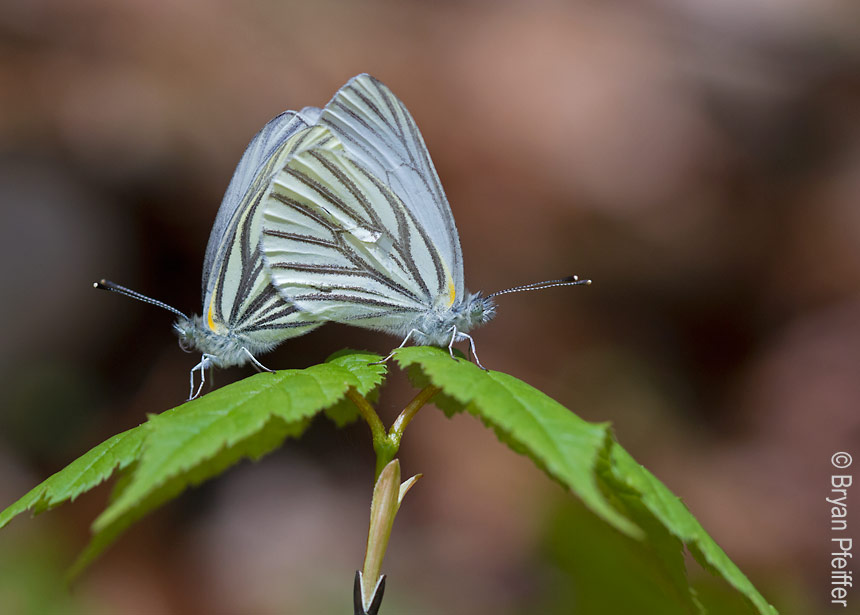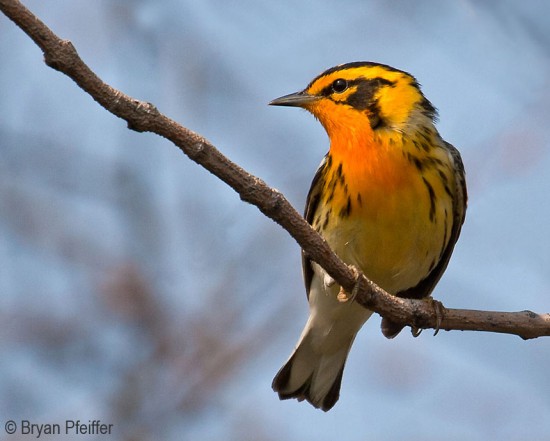Dirty Insect Image No. 4: Mustard Whites

Mustard Whites (Pieris napi) making more Mustard Whites / © Bryan Pfeiffer
ON THE ROLLING PLATEAU of Craftsbury, Vermont, with big views toward the Green Mountains, in woods rich with warblers and wildflowers, beside a vernal pool blackened with wood frog tadpoles, and on day when the north breeze swept away the black flies, two butterflies found each other. And I found them.
In my continuing series of Dirty Insect Images, this pair of Mustard Whites (Pieris napi) spent about 10 minutes copulating on a red maple seedling yesterday. These elegant whites, among our season’s first butterflies, are proof that the introduced Cabbage White (Pieris rapae) isn’t the only gossamer white flying at your ankles (and in your garden) this spring.
Mustard Whites drift through our woodlands and along their paths, searching for, well, uh, duh, for other Mustard Whites – and for mustard family plants on which to lay eggs. In calcium-rich woods they find annual herbs in the genus Dentaria, spring wildflowers with nodding pale flowers we call “toothworts.”

Blackburnian Warbler / © Bryan Pfeiffer
Although Mustard Whites fare well here in Vermont, the non-native, introduced mustards Wintercress (Barbarea vulgaris) and Garlic Mustard (Alliaria petiolata) offer false hope for this butterfly. Females misidentify these mustards as suitable hosts for their eggs, yet the caterpillars often cannot mature my munching these alien mustards alone. It’s of particular concern for a rare cousin of the Mustard White, West Virginia White (Pieris virginiensis), which reaches its northernmost U.S. extent in rich, moist woods here in Vermont.
So the next time a white butterfly lands nearby, drop to your belly. If you see veins on the underside if its hind wings you’ll be in the good company of no Cabbage White but rather one of our woodland “veined whites.”
While you’re down there, roll over and look up. Spring migration peaks here in Vermont this week. During a gathering of the Natural History Network in Craftsbury this past weekend, where I spied on those Mustard Whites, we also managed to locate 66 bird species, with full-frontal views of 17 warbler species, including Bay-breasted Warbler, Cape May Warbler and Tennessee Warbler. Here’s the bird list.
Bird List – Great Hosmer Pond East to the Black River
Craftsbury, Vermont
17-18 May 2014
- Canada Goose
- Wood Duck
- Mallard
- Hooded Merganser
- Ruffed Grouse
- Common Loon
- American Bittern
- Great Blue Heron
- Turkey Vulture
- Broad-winged Hawk
- Bald Eagle
- Mourning Dove
- Barred Owl
- Yellow-bellied Sapsucker
- Hairy Woodpecker
- Black-backed Woodpecker
- Northern Flicker
- Pileated Woodpecker
- Eastern Phoebe
- Great Crested Flycatcher
- Blue-headed Vireo
- Red-eyed Vireo
- Blue Jay
- American Crow
- Common Raven
- Black-capped Chickadee
- Red-breasted Nuthatch
- Brown Creeper
- Winter Wren
- Golden-crowned Kinglet
- Ruby-crowned Kinglet
- Eastern Bluebird
- Veery
- Hermit Thrush
- American Robin
- Gray Catbird
- European Starling
- Ovenbird
- Northern Waterthrush
- Black-and-white Warbler
- Tennessee Warbler
- Nashville Warbler
- Common Yellowthroat
- Cape May Warbler
- Northern Parula
- Magnolia Warbler
- Bay-breasted Warbler
- Blackburnian Warbler
- Yellow Warbler
- Chestnut-sided Warbler
- Black-throated Blue Warbler
- Yellow-rumped Warbler
- Black-throated Green Warbler
- Canada Warbler
- Chipping Sparrow
- Song Sparrow
- Swamp Sparrow
- White-throated Sparrow
- White-crowned Sparrow
- Dark-eyed Junco
- Scarlet Tanager
- Rose-breasted Grosbeak
- Red-winged Blackbird
- Common Grackle
- Brown-headed Cowbird
- Purple Finch
- American Goldfinch

Great Bird List Bryan, When do you go towards Monheagan?
Beautiful image of the Mustard Whites, Bryan! New one to me, I think!
Yep, eBirded it! About to eButterfly it! (They
are
verbs, you know.)
I am sure you entered your checklists in Vermont eBird and eButterfly 🙂